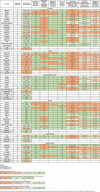Emergency Medicine Around the World: Analysis of the 2019 American College of Emergency Physicians International Ambassador Country Reports
- PMID: 35252974
- PMCID: PMC8886186
- DOI: 10.1002/emp2.12681
Emergency Medicine Around the World: Analysis of the 2019 American College of Emergency Physicians International Ambassador Country Reports
Abstract
Objective: The specialty of emergency medicine and recognition of the need for emergency care continue to grow globally. The specialty and emergency care systems vary according to context. This study characterizes the specialty of emergency medicine around the world, trends according to region and income level, and challenges for the specialty.
Methods: We distributed a 56-question electronic survey to all members of the American College of Emergency Physicians International Ambassador Program between March 2019 and January 2020. The Ambassador Program leadership designed the survey covering specialty recognition, workforce, system components, and emergency medicine training. We analyzed results by country and in aggregate using SAS software (SAS Institute Inc). We tested the associations between World Bank income group and number of emergency medicine residency-trained physicians (RTPs) and emergency medicine specialty recognition using non-parametric Fisher's exact testing. We performed inductive coding of qualitative data for themes.
Results: Sixty-three out of 78 countries' teams (80%) responded to the survey. Response countries represented roughly 67% of the world's population and included countries in all World Bank income groups. Fifty-four countries (86%) recognized emergency medicine as a specialty. Ten (16%) had no emergency medicine residency programs, and 19 (30%) had only one. Eight (11%) reported having no emergency medicine RTPs and 30 (48%) had <100. Fifty-seven (90%) had an emergency medical services (EMS) system, and 52 (83%) had an emergency access number. Higher country income was associated with a higher number of emergency medicine RTPs per capita (P = 0.02). Only 6 countries (8%) had >5 emergency medicine RTPs per 100,000 population, all high income. All 5 low-income countries in the sample had <2 emergency medicine RTPs per 100,000 population. Challenges in emergency medicine development included lack of resources (38%), burnout and poor working conditions (31%), and low salaries (23%).
Conclusions: Most surveyed countries recognized emergency medicine as a specialty. However, numbers of emergency medicine RTPs were small, particularly in lower income countries. Most surveyed countries reported an EMS system and emergency access number. Lack of resources, burnout, and poor pay were major threats to emergency medicine growth.
Keywords: emergency medical services; emergency medicine; global health; graduate medical education; healthcare delivery; international health; public health.
© 2022 The Authors. JACEP Open published by Wiley Periodicals LLC on behalf of American College of Emergency Physicians.
Conflict of interest statement
The authors have no conflicts of interest to declare.
Figures




References
-
- World Health Assembly . WHA60.22. Health systems: emergency‐care systems. https://apps.who.int/iris/bitstream/handle/10665/22596/A60_R22‐en.pdf?se.... Published 2007. Accessed July 30, 2021.
LinkOut - more resources
Full Text Sources
